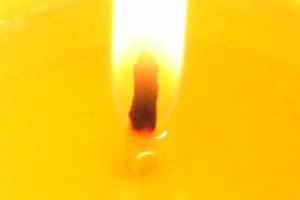 Why would we do that you might ask? Well simply because we want to see how well they burn compared to our own beeswax candles. We test and retest our beeswax Honey Candles® here in our office. All that testing has paid off and here is a beautifully burning Honey Candles® Pillar. It is not unusual to come to work to half a dozen beeswax candles burning throughout the office as we test a new wick or potential new product. The room fills with the scent of warm luxurious beeswax. You can feel special working here.
Why would we do that you might ask? Well simply because we want to see how well they burn compared to our own beeswax candles. We test and retest our beeswax Honey Candles® here in our office. All that testing has paid off and here is a beautifully burning Honey Candles® Pillar. It is not unusual to come to work to half a dozen beeswax candles burning throughout the office as we test a new wick or potential new product. The room fills with the scent of warm luxurious beeswax. You can feel special working here.
We often test other popular beeswax candle brands. I want to share with you some of what we have found over the years, but don’t take our word for it. Look and ours and look at theirs and see for yourself. Try them both out!

 When examining a competitor’s pillar, we noticed that as we ‘looked through’ the beeswax it appeared darker on the inside. The bottom of the pillar appeared ‘dirty’. We scrapped off some of the outside wax and the photo shows what we found. Notice the darker wax underneath, with a layer of cleaner wax on the surface. We believe this is a result of ‘overdipping’ an inferior cheap wax with a higher quality wax. See this same ‘overdipped’ candle burning. The wick is thick and coarse and there are impurities in the wax pool.
When examining a competitor’s pillar, we noticed that as we ‘looked through’ the beeswax it appeared darker on the inside. The bottom of the pillar appeared ‘dirty’. We scrapped off some of the outside wax and the photo shows what we found. Notice the darker wax underneath, with a layer of cleaner wax on the surface. We believe this is a result of ‘overdipping’ an inferior cheap wax with a higher quality wax. See this same ‘overdipped’ candle burning. The wick is thick and coarse and there are impurities in the wax pool.
 When you are choosing a candle to buy, watch for holes in the bottom as seen in this photo. When we cut this competitor’s candle open we found a significant cavity inside. This will reduce the quality and time of the burn. If a hole like this was noticed in a candle in our shop it would be culled. All Honey Candles® have a smooth finish without holes or cavities.
When you are choosing a candle to buy, watch for holes in the bottom as seen in this photo. When we cut this competitor’s candle open we found a significant cavity inside. This will reduce the quality and time of the burn. If a hole like this was noticed in a candle in our shop it would be culled. All Honey Candles® have a smooth finish without holes or cavities.
 Wicks can sometimes ‘mushroom’ or develop a carbon cap. It is more common with pillar or taper wicks. When this happens it is time to trim the wick or it will likely smoke. It can be an issue with tealights as well. Here is a Honey Candles® Tealight on the left and another brand on the right.The carbon cap from the tealight wick on the right has 'mushroomed' and needs to be trimmed. Eventually it burned through and broke off and continued to burn in the wax pool!
Wicks can sometimes ‘mushroom’ or develop a carbon cap. It is more common with pillar or taper wicks. When this happens it is time to trim the wick or it will likely smoke. It can be an issue with tealights as well. Here is a Honey Candles® Tealight on the left and another brand on the right.The carbon cap from the tealight wick on the right has 'mushroomed' and needs to be trimmed. Eventually it burned through and broke off and continued to burn in the wax pool!
One of the most frequently asked questions when customers want to know about Honey Candles® compared to other beeswax candles is regarding burn times. The burn times listed for Honey Candles® is a start to finish time. This means it is timed in one complete period. When a candle is extinguished and relit several times, the length of burn will be significantly longer. If a burn time listed seems exaggerated, then you must look at the quality of the burn. A very low insignificant flame will result in a long burn. This is often true for soy wax candles.
One of our retailers switched to a brand with lower prices. She and her customers were not impressed with the quality of the appearance, smell or burn and then discovered that the candles were made in China with Chinese beeswax. In many cases in China the bees are not allowed to free range on flowers. They are only fed sugar water. This means the beeswax does not have that sweet honey smell nor the golden color and smooth appearance of premium quality beeswax. She switched back to Honey Candles®.
Here is a list of key points to look for when buying your beeswax candles:
Wax Look for even color throughout the candle. The wax should be rich and clean with nicely finished edges, as opposed to dark wax under the surface or impurities or dirt in the wax. Premium quality beeswax is a yellow-amber that is rich and intense. Lower grades of beeswax are gray-green and muddy in appearance.
Bloom All 100% beeswax candles will develop a white 'bloom' over time. This is an indicator of purity and is cherished by candle connoisseurs. Beeswax candles that have been blended with other waxes will not develop bloom. If you prefer a polished look simply buff with a soft cloth, cheese cloth or nylon.
Finish There should be a flawless depth to the finish without surface flakes, cracks or white spots.
- The surface of pillars and tapers should be smooth with the appearance of being solid throughout. There should not be holes or cavities.
- Votives should be round and symmetrical to fit snugly in a votive cup. The tops should be nicely rounded and full to obtain full burn time. The wicks should be centered.
- Tealights may be small, but are very sensitive to quality. If the wax is filled higher than the cup they are sold in, it will spill over when burned. If they are too low, you will not get the length of burn you expected. The wicks should be centered.
Wick There are many types of candlewick available. The type and size of the wick is an integral part of the burn quality. The best way for you to tell is to burn the candle as recommended by the manufacturer and look for a quality flame, minimal “mushrooming” and complete wax consumption. For ideal burning the wick needs to be centered in the candle. The manufacturer should have taken care to trim the wick, but you may have to trim if needed.
We want you to enjoy your beeswax candles and to know that you have purchased the best candles for your family’s health. We want you to feel that you have received good value for your hard earned dollars. Tell us about how you feel about the beeswax candles you purchase.










